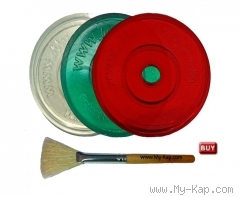The Fill ‘n Brew disposable Cup Kit claims you can save up to 70% over K-Cup Packs. We did the math and we sampled the coffee this system offers.
The notion of do-it-yourself K-Cups has been around for almost as long as Keurig itself. The reasons for “rolling your own” cups are many, but the most-mentioned are:
- Save money.
- Use your own roast or pack a specialty roast
- Save money.
- Be a little greener by pulling the paper filter and grounds and composting them
- And finally, to save money.
The Fill ‘n Brew kit, distributed by Jacent Strategic Merchandising of Pennsylvania, contains the makings of 24 home made K-Cups. Purchased in the coffee gadget section of my local supermarket, the packaging boldly declares users could save up to 70% over K-Cup Packs. I honestly don’t recall what I paid for it at the store, but the same kit is available at the time of this writing for $5.49 at Walmart.com. The kit comes with two bundles of loosely-packed paper filters, the plastic cups marked with recycling type 5 (more on that later), clear snap on lids with pre-cut chad for a classic Keurig injector. Also included is a plastic support stand to aid in stabilizing the cup while the top is snapped on and an adapter clip intended for Keurig Plus models. Please note that this kit (as well as most DYI systems on the market) do not work with the latest “multi-stream” Keurig models currently available.
How hard is it to use?
Kits like this will often have little issues an quirks. Many I’ve tried have the paper filters so tightly packed they are hard to separate. Others have loose fitting caps or lids that will leak or weep under pressure. I can report that I had no issues with the Fill ‘n Brew Kit. The filters separated easily for my hammy guy fingers and the supplied holder makes loading and capping the cup largely problem free.
I would suggest using a coffee measure that is narrow enough to let you easily pour into the mouth of the cup. A standard tablespoon measure is a little wide and some of your coffee will try to escape. A measure with a pour spout like this one was a real help.
I found that after the first couple, I could prepare and fill a cup in about a minute.
To offer the warning once again, this kit does not work with the more recent Keurig releases using multi-stream technology. I tried and I would up with a mess. The kit clearly states the cups will work with Keurig Original 2.0 and Plus series machines. Don’t try to sneak these into the new Keurig you just got for Christmas. You’ll be spending an hour cleaning up the mess.
How’s the coffee?
I used Lavazza Classico pre-ground coffee for my testing. I found the filter would comfortably hold about a 1-1/4 tablespoon of coffee, which I think is a little light for a strong large cup of Keurig-brewed coffee (No, I didn’t weigh the individual portions, I wanted a cup of coffee, not a science experiment). I found cups brewed at the medium setting were of a good strength and pleasant to drink. No escaped grounds and the paper filter pulled some of the oil out of the brew, giving it a smoother taste than a cup made with a mesh screen cup. If you’re after a really bold cup, either go with a kit with a mesh strainer or one that can hold a greater coffee load.
Is it green?
No, not really. The cups are polypropylene, a plastic that is largely unrecycled. New processes are available to recycle this plastic, but don’t kid yourself thinking you’re doing Mother Earth a favor by using this kit. As a matter of fact, EVERTHING in this kit besides the filters, instruction sheet and front label is made of hard plastic. You can probably do some good by pulling out the used, wet filter and dropping the grounds into your garden, but that’s about it. It would be possible to reuse the individual cups a few more times with fresh filters and caps, but that gets to be a messy and laborious affair. Not recommended. The Keurig system was never focused on being overly green, and there really isn’t a good solution available at this time.
Is it cheap?
The claim that you can save 70% over store bought cups can be true if you compare the kit to the most expensive preloaded K-Cups available. I did the math and found that making my own from a 10 oz. bag of Lavazza and the Fill ‘n brew kit worked out to be about 50 cents a drink. To improve upon that cost in preloaded Lavazza cups one had to bulk purchase 160 from a vendor on Amazon. At my grocery store, the same cups cost $1.13 per unit when buying a little box of 10. So yes, the DYI route is worth it in money saved. The savings should get a little better when you buy refill filters, cups and caps.



















